Colonization potential to reconstitute a microbe community in patients detected early after fecal microbe transplant for recurrent C. difficile
- PMID: 26758906
- PMCID: PMC4711103
- DOI: 10.1186/s12866-015-0622-2
Colonization potential to reconstitute a microbe community in patients detected early after fecal microbe transplant for recurrent C. difficile
Abstract
Background: Fecal microbiota transplants (FMT) are an effective treatment for patients with gut microbe dysbiosis suffering from recurrent C. difficile infections. To further understand how FMT reconstitutes the patient's gut commensal microbiota, we have analyzed the colonization potential of the donor, recipient and recipient post transplant fecal samples using transplantation in gnotobiotic mice.
Results: A total of nine samples from three human donors, recipient's pre and post FMT were transplanted into gnotobiotic mice. Microbiome analysis of three donor fecal samples revealed the presence of a high relative abundance of commensal microbes from the family Bacteriodaceae and Lachnospiraceae that were almost absent in the three recipient pre FMT fecal samples (<0.01%). The microbe composition in gnotobiotic mice transplanted with the donor fecal samples was similar to the human samples. The recipient samples contained Enterobacteriaceae, Lactobacillaceae, Enterococcaceae in relative abundance of 43, 11, 8%, respectively. However, gnotobiotic mice transplanted with the recipient fecal samples had an average relative abundance of unclassified Clostridiales of 55%, approximately 7000 times the abundance in the recipient fecal samples prior to transplant. Microbiome analysis of fecal samples from the three patients early (2-4 weeks) after FMT revealed a microbe composition with the relative abundance of both Bacteriodaceae and Lachnospiraceae that was approximately 7% of that of the donor. In contrast, gnotobioitc mice transplanted with the fecal samples obtained from the three at early times post FMT revealed increases in the relative abundance of Bacteriodaceae and Lachnospiraceae microbe compositions to levels similar to the donor fecal samples. Furthermore, the unclassified Clostridiales in the recipient samples post FMT was reduced to an average of 10%.
Conclusion: We have used transplantation into gnotobiotic mice to evaluate the colonization potential of microbiota in FMT patients early after transplant. The commensal microbes present at early times post FMT out competed non-commensal microbes (e.g. such as unclassified Clostridiales) for niche space. The selective advantage of these commensal microbes to occupy niches in the gastrointestinal tract helps to explain the success of FMT to reconstitute the gut microbe community of patients with recurrent C. difficile infections.
Figures
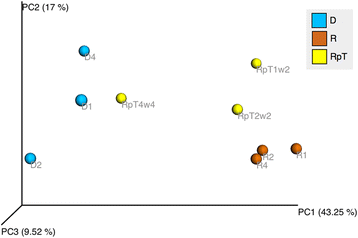
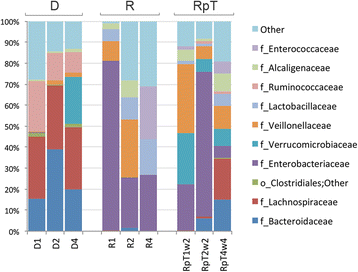

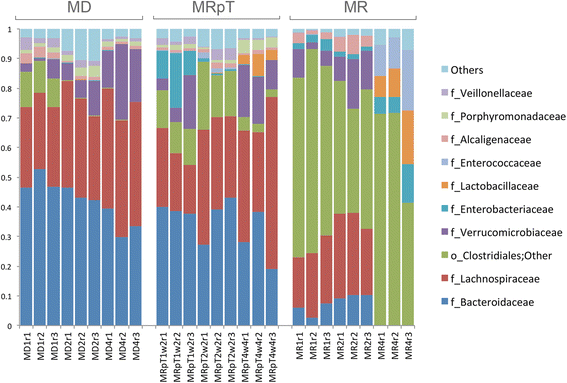
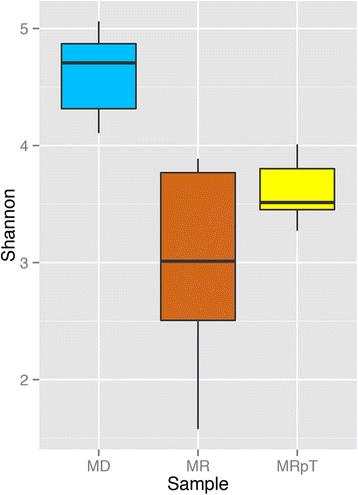
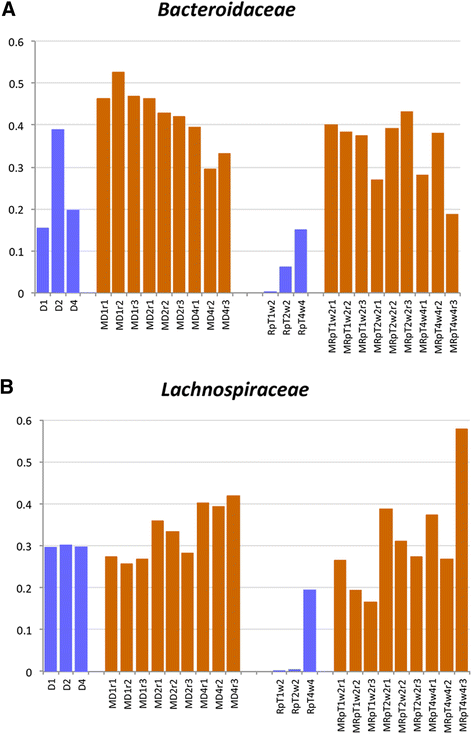
Similar articles
-
Longitudinal microbiome analysis of single donor fecal microbiota transplantation in patients with recurrent Clostridium difficile infection and/or ulcerative colitis.PLoS One. 2018 Jan 31;13(1):e0190997. doi: 10.1371/journal.pone.0190997. eCollection 2018. PLoS One. 2018. PMID: 29385143 Free PMC article.
-
Recovery of the gut microbiome following fecal microbiota transplantation.mBio. 2014 Jun 17;5(3):e00893-14. doi: 10.1128/mBio.00893-14. mBio. 2014. PMID: 24939885 Free PMC article. Clinical Trial.
-
Incongruence between dominant commensal donor microbes in recipient feces post fecal transplant and response to anti-PD-1 immunotherapy.BMC Microbiol. 2021 Sep 20;21(1):251. doi: 10.1186/s12866-021-02312-0. BMC Microbiol. 2021. PMID: 34544375 Free PMC article.
-
The role of the gut microbiome in colonization resistance and recurrent Clostridioides difficile infection.Therap Adv Gastroenterol. 2022 Nov 18;15:17562848221134396. doi: 10.1177/17562848221134396. eCollection 2022. Therap Adv Gastroenterol. 2022. PMID: 36425405 Free PMC article. Review.
-
Understanding the mechanisms of efficacy of fecal microbiota transplant in treating recurrent Clostridioides difficile infection and beyond: the contribution of gut microbial-derived metabolites.Gut Microbes. 2020 Nov 9;12(1):1810531. doi: 10.1080/19490976.2020.1810531. Gut Microbes. 2020. PMID: 32893721 Free PMC article. Review.
Cited by
-
An individualized mosaic of maternal microbial strains is transmitted to the infant gut microbial community.R Soc Open Sci. 2020 Apr 15;7(4):192200. doi: 10.1098/rsos.192200. eCollection 2020 Apr. R Soc Open Sci. 2020. PMID: 32431894 Free PMC article.
-
The Impact of a Dried Fruit and Vegetable Supplement and Fiber Rich Shake on Gut and Health Parameters in Female Healthcare Workers: A Placebo-Controlled, Double-Blind, Randomized Clinical Trial.Microorganisms. 2021 Apr 14;9(4):843. doi: 10.3390/microorganisms9040843. Microorganisms. 2021. PMID: 33920059 Free PMC article.
-
Fecal Microbiota Transplantation as New Therapeutic Avenue for Human Diseases.J Clin Med. 2022 Jul 15;11(14):4119. doi: 10.3390/jcm11144119. J Clin Med. 2022. PMID: 35887883 Free PMC article. Review.
-
The role of fecal microbiota transplantation in selected neurodegenerative diseases and neurodevelopmental disorders.Prz Gastroenterol. 2025;20(2):127-141. doi: 10.5114/pg.2024.146118. Epub 2024 Dec 22. Prz Gastroenterol. 2025. PMID: 40620312 Free PMC article. Review.
-
Colonization Potential to Reconstitute a Microbe Community in Pseudo Germ-Free Mice After Fecal Microbe Transplant From Equol Producer.Front Microbiol. 2020 Jun 5;11:1221. doi: 10.3389/fmicb.2020.01221. eCollection 2020. Front Microbiol. 2020. PMID: 32582121 Free PMC article.
References
Publication types
MeSH terms
Grants and funding
LinkOut - more resources
Full Text Sources
Other Literature Sources

